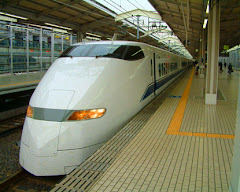Friday, August 29, 2008
WE DID IT!!
http://www.mcall.com/news/local/all-a1_4rails-aug29,0,3068682.story
Sunday, August 24, 2008
Monday, August 18, 2008
Thursday, August 14, 2008
Downtowns Across the U.S. See Streetcars in Their Future
http://www.nytimes.com/2008/08/14/us/14streetcar.html
Wednesday, August 13, 2008
Over One Hundred Area Residents Attend Fast- Track Rail Strategy Session at the Allentown Brew Works

Over one hundred citizens looking for long term solutions, found hopeful answers at the Allentown Brew Works last evening, Tuesday, August 12.
After last minute requests by several Allentown residents, Paul J. Marin, Transportation Committee Chairman of the Lehigh Valley Economic Development Corporation, shared his strategy for bringing passenger rail service to the Lehigh Valley: A Unified Passenger Rail Network for Eastern Pennsylvania
This network concept unites six separate rail expansion projects for Eastern Pennsylvania that were seen as independent projects. A rail network will help reduce the need for short-distance airline flights and preserve mobility in the face of rising fuel prices.
Pennsylvania is ALREADY ACTIVELY PLANNING RAIL EXPANSION:
Currently, six rail proposals are being developed in eastern Pennsylvania:
Scranton to New York commuter rail.
Easton to New York commuter rail.
Reading to Philadelphia commuter rail
Harrisburg, Hershey, York, Lancaster commuter rail system.
Quakertown to Philadelphia commuter rail.
The Crescent Corridor/Norfolk Southern freight capacity project
Instead of individual corridors, Marin proposed that these rail projects should be combined into a seamless network that will be far superior to any isolated individual rail line.
Marin argued that there are numerous advantages to this approach:
The corridors would be completely integrated to allow for travel to any other point in the system.
“For example, a Scranton resident could travel by train to New York, Philadelphia, Harrisburg, Reading, Allentown, Baltimore, Washington DC, Atlantic City, or virtually anywhere else in the northeast. This is a dramatic improvement in mobility as compared to individual corridor projects.”
Increase of ridership: The network would inherently encourage more ridership because it connects more places together.
Reduce operating costs.
Increase economic development in Pennsylvania’s smaller cities: The network connects the downtowns of the various communities in Eastern Pennsylvania. It will become even more attractive to live and do business in these downtowns when convenient, fast train travel is offered to all the major urban centers in the northeast.
Affordable mobility in an era of rising fuel prices: Rising fuel prices are reducing driving and flying. As long as fuel prices remain high or increase, mobility will be reduced. A regional train network can withstand increases in fuel costs and provide affordable mobility to travel.
Relieve airport congestion: Many flights could be converted into rail trips, freeing up space for longer distance flights to operate without congestion. Many airlines are cutting flights. Some carriers are eliminating 10% to 20% of flights by the end of 2008, and many small cities are losing air service. A rail network offers an important mobility option that can withstand rising fuel prices.
Pennsylvania is already set up for rail service:
“Passenger rail depends on high population densities, interconnected economies, and walkable cities. Pennsylvania has all three.”
Marin exclaimed: “Fast-Track Implementation is possible.” He added: “Because of rising fuel prices and a slowing economy, there is no time to lose in moving forward.”
As an example, he pointed to the State of New Mexico. It announced a new commuter rail line in 2003 and opened it for business in 2006 – just three years later. This amazingly rapid implementation occurred because of firm commitment by Governor Bill Richardson and exceptional professionalism by the department of transportation.
The crowd was extremely enthusiastic and unanimous in its support for passenger rail. Individuals repeatedly asked how they could get slow-moving politicians to make this a priority. An email group was formed. It was agreed by many after the presentation, that the creation of a citizen-action oriented blog would empower residents to make elected leaders understand that unified rail is a huge priority.
A Blog is Born
Why do elected leaders think nothing of spending hundreds of millions on widening roads (such as a few mile stretch on 22) and hesitate when asked about spending far less on creating passenger rail?
Do not sit silently when some politicians or bureaucrats caution rail service could take many years. We must speak in a more powerful united voice and DEMAND PASSENGER RAIL NOW!
It is every citizens' responsibility to hold every elected official's feet to the fire. They have an obligation to prioritize this and PUT LEHIGH VALLEY ON THE FAST TRACK!








